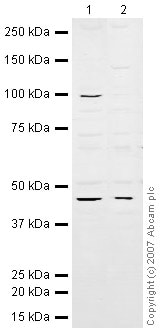Anti-eIF4A3 antibody (ab32485)
Key features and details
- Rabbit polyclonal to eIF4A3
- Suitable for: IHC-P, IP, ICC/IF, WB
- Reacts with: Mouse, Rat, Human
- Isotype: IgG
Overview
-
Product name
Anti-eIF4A3 antibody
See all eIF4A3 primary antibodies -
Description
Rabbit polyclonal to eIF4A3 -
Host species
Rabbit -
Tested Applications & Species
See all applications and species dataApplication Species ICC/IF HumanIHC-P HumanIP HumanWB MouseHuman -
Immunogen
Synthetic peptide corresponding to Human eIF4A3 aa 1-100.
(Peptide available asab32484) -
General notes
The Life Science industry has been in the grips of a reproducibility crisis for a number of years. Abcam is leading the way in addressing the problem with our range of recombinant monoclonal antibodies and knockout edited cell lines for gold-standard validation.
One factor contributing to the crisis is the use of antibodies that are not suitable. This can lead to misleading results and the use of incorrect data informing project assumptions and direction. To help address this challenge, we have introduced an application and species grid on our primary antibody datasheets to make it easy to simplify identification of the right antibody for your needs.
Learn more here.
Images
-
Anti-eIF4A3 antibody (ab32485) at 1 µg/ml + HeLa (Human epithelial carcinoma cell line) Nuclear Lysate at 20 µg
Secondary
IR Dye 680 Conjugated Goat Anti-Rabbit IgG (H+L) at 1/15000 dilution
Performed under reducing conditions.
Predicted band size: 47 kDa
Observed band size: 47 kDa
-
eIF4A3 was immunoprecipitated using 0.5mg Hela whole cell extract, 5µg of Rabbit polyclonal to eIF4A3 and 50µl of protein G magnetic beads (+). No antibody was added to the control (-).
The antibody was incubated under agitation with Protein G beads for 10min, Hela whole cell extract lysate diluted in RIPA buffer was added to each sample and incubated for a further 10min under agitation.
Proteins were eluted by addition of 40µl SDS loading buffer and incubated for 10min at 70°C; 10µl of each sample was separated on a SDS PAGE gel, transferred to a nitrocellulose membrane, blocked with 5% BSA and probed with ab32485.
Secondary: Mouse monoclonal [SB62a] Secondary Antibody to Rabbit IgG light chain (HRP) (ab99697).
Band: 47kDa; eIF4A3
-
All lanes : Anti-eIF4A3 antibody (ab32485) at 1 µg/ml
Lane 1 : MEF1 (Mouse embryonic fibroblast cell line) Whole Cell Lysate
Lane 2 : PC12 (Rat adrenal pheochromocytoma cell line) Whole Cell Lysate
Lysates/proteins at 10 µg per lane.
Secondary
All lanes : IRDye 680 Conjugated Goat Anti-Rabbit IgG (H+L) at 1/10000 dilution
Performed under reducing conditions.
Predicted band size: 47 kDa
Observed band size: 46 kDa why is the actual band size different from the predicted?
Additional bands at: 100 kDa. We are unsure as to the identity of these extra bands.
-
ICC/IF image of ab32485 stained human HeLa cells. The cells were PFA fixed (10 min), permabilised in TBS-T (20 min) and incubated with the antibody (ab32485, 5µg/ml) for 1h at room temperature. 1%BSA / 10% normal serum / 0.3M glycine was used to quench autofluorescence and block non-specific protein-protein interactions. The secondary antibody (green) was Alexa Fluor® 488 goat anti-rabbit IgG (H+L) used at a 1/1000 dilution for 1h. Alexa Fluor® 594 WGA was used to label plasma membranes (red). DAPI was used to stain the cell nuclei (blue).
-
 Immunohistochemistry (Formalin/PFA-fixed paraffin-embedded sections) - Anti-eIF4A3 antibody (ab32485)IHC image of eIF4A3 staining in human skin FFPE section, performed on a Leica BondTM system using the standard protocol F. The section was pre-treated using heat mediated antigen retrieval with sodium citrate buffer (pH6, epitope retrieval solution 1) for 20 mins. The section was then incubated with ab32485, 1µg/ml, for 15 mins at room temperature and detected using an HRP conjugated compact polymer system. DAB was used as the chromogen. The section was then counterstained with haematoxylin and mounted with DPX.
Immunohistochemistry (Formalin/PFA-fixed paraffin-embedded sections) - Anti-eIF4A3 antibody (ab32485)IHC image of eIF4A3 staining in human skin FFPE section, performed on a Leica BondTM system using the standard protocol F. The section was pre-treated using heat mediated antigen retrieval with sodium citrate buffer (pH6, epitope retrieval solution 1) for 20 mins. The section was then incubated with ab32485, 1µg/ml, for 15 mins at room temperature and detected using an HRP conjugated compact polymer system. DAB was used as the chromogen. The section was then counterstained with haematoxylin and mounted with DPX.
























